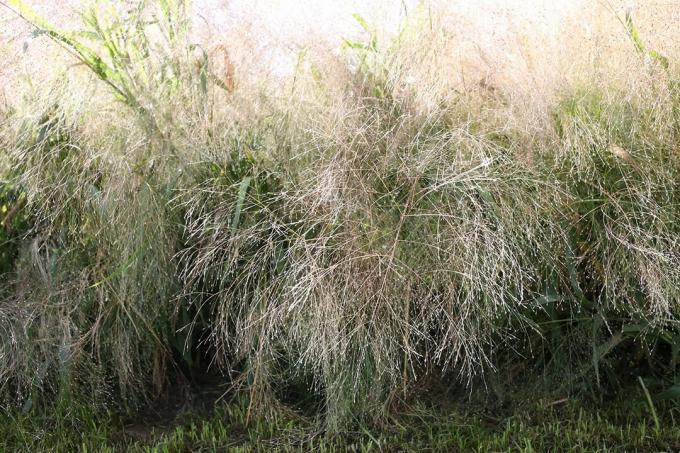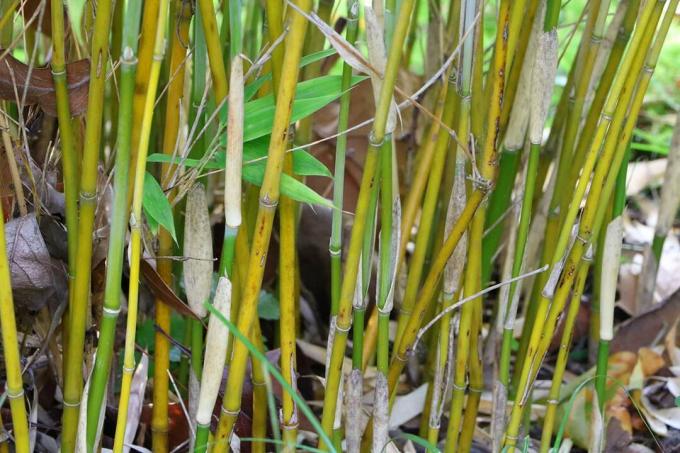

Table of contents
- Sowing and Propagation of Blue Moor-Grass
- Planting and caring for moor grass
- Location
- Pour
- Fertilize
- Cut
- hibernate
- diseases and pests
- Peculiarities of moor grass
- Known Varieties of Blue Moor-Grass
- Worth knowing about the blue moor grass in brief
The growth height of blue moor grass is usually 50 to 100 cm. The flower panicles, in which the seeds are hidden, are also 5 to 50 cm long. The flower spikes are also blue-violet in color. The moor grass can enchant the garden with a wonderful bloom between the months of July and September. It could also be as reedbe described as a plant that gardeners like to plant around the pond.
Sowing and Propagation of Blue Moor-Grass
The Molinia caerula Grass plant occurs in almost all areas. If you pass an open nature area, you will recognize this type of grass from afar. So it is actually obsolete to buy the seeds for the grass in a shop:
- Simply pull the seeds from the Molinia caerula and set them to germinate.
- For this it is sufficient if you press the seed lightly against the earth in a pot full of soil.
- The first seedling should be visible within two weeks.
- If the thermometer falls below 15 °C, the seed cannot germinate! The temperature should therefore be a constant 20 °C.
- As soon as the seedling has grown 10 cm, you can put it in the garden.
- Of course, you can also start sowing seeds in the garden immediately and mark the ground with some sand.
- If you are striving for further propagation of the grass, you can now take seeds from your own flowers and pull them up again.
Planting and caring for moor grass
Once the moor grass has grown, it is easy to manage. It is almost undemanding and can survive several days without water. However, it must not become too dry, otherwise it has no chance of surviving.
The Molinia caerula requires little maintenance. The plant itself is completely undemanding and only needs moderate water. In winter, the grass can be left outdoors and please the owner's eyes with the magnificent color. As a location, it is advantageous if you choose a sunny or semi-shady place. The blue moor grass likes to grow at the edge of the pond or between trees. In order for the plants to grow extensively, a humus-rich soil is required. The Molinia caerula should be pruned in the spring so that it can grow beautifully and colorfully again during the summer.
Location
Choose a sunny or partially shaded place for the Molinia caerula. Soil should be neutral to acidic, well drained and moist. The grass survives a dry period unscathed. So you can go on holiday with peace of mind and come home knowing that weed is still in place, in full size and health.
Pour
In summer, the Molinia caerula needs a little more water. However, two to three times a week is quite sufficient.
Fertilize
In winter, the Molinia caerula does not require any fertilizer. In summer it is sufficient if you add a shot of fertilizer to the irrigation water once every two months.
Cut
In order for the blue moor grass to grow year after year, it should be cut close to the ground in the spring of each year. You can then dry the weed and set it up in a vase as a dried bouquet.
hibernate
No special measures are necessary for overwintering. Protect the soil somewhat from frost by scattering wood chips or pellets between the blades of grass.
diseases and pests
The blue moor grass is not attacked by any pest, so there are no problems here either. Diseases are also unknown.
Peculiarities of moor grass
This grass is a protected species that occurs in nature, especially in bog areas. Plants of this genus can also be found in Europe and western Asia. if you a create a bog bed want, the blue moor grass is made for it. It can also be cultivated well in a pot. The leaves and flowers are easy to cut and dry. Due to the optimal properties of the plant, it is suitable for novice gardeners. Heath gardens or wild gardens become an admirable area with the grass.
Known Varieties of Blue Moor-Grass
There are many cultivars that fall under the term "blue moor grass":
- Heather is also a blue moor grass and reaches an amazing height of 150 cm when flowering.
- Moorflame also belongs to the blue moor grass family. A wonderful violet-red and also autumnal coloring develops, which gives off a fantastic color picture.
- The moor witch can be seen in autumn with a golden yellow coloration. In addition, there are purple ears and a height of about 80 cm. A species of blue moor grass is called transparent and fascinates with a graceful growth and a height of approx. 50 cm.
- The Windspiel plant grows almost upright to a height of 180 cm and also fascinates with a great color scheme.
Worth knowing about the blue moor grass in brief
The blue moor grass has a natural origin and is one of the protected grass species. It is easy to care for and is hardly attacked by pests. It does not require any special care and is therefore ideal for game or heather garden suitable. In addition, the Molinia caerula Grass plant sown by ponds to create a natural wind barrier. Even strong winds cannot harm the blue moor grass.
- Type/Family: a perennial belonging to the grass family (Poaceae) heard
- Maintenance effort: low, easy to care for, undemanding and robust
- Blossom: sit in loose panicles on upright flower stalks, which in turn radiate out from the leaves
- heyday: July to October with dark purple to light brown spikes, golden yellow in autumn
- foliage: narrow, linear green leaves with striking golden-yellow autumn colors, also attractive in winter
- Growth: bushy, upright, forming dense clumps
- Height: depending on the variety, tufts of leaves 20 to 60 cm, with inflorescences 50 to 200 cm
- Location: Sunny to semi-shady, likes in front of and between trees and at the edge of the pond
- substrate: more humic, moist, but well drained, neutral to acidic
- planting time: at any time as long as the ground is not frozen, can also be sown in spring
- Cut: Spring close to the ground
- Partner: fits nicely in a carpet of cushion grasses such as bluefescue, where there are contrasts, also a beautiful partner for autumn asters
- propagation: division in spring
- Care: water if drought persists, fertilize combined with pruning in spring
- Wintering: hardy
- Particularities: occurs naturally in the moorlands of Europe and Western Asia
- Use: both leaves and inflorescences are easy to cut and dry
 garden editorial
garden editorial I write about everything that interests me in my garden.
Learn more about ornamental grasses

cutting bamboo | When and how to cut back bamboo?
Be it as a hedge, solitaire or ground cover, bamboo can be seen more and more often in home gardens. Because the sweet grass is easy to care for and easy to grow. However, the latter can quickly become a problem if the plants are not pruned regularly.

11 Tips for Cutting Grasses | Tools & Co.
Cutting ornamental grass works best with our tips: From choosing the right tool to right time - we have the most useful tips and tricks for you for the annual grass cut summarized.

Switchgrass, Panicum virgatum: Care from A – Z
Switchgrass is an upright-growing, clump-forming grass with narrow leaves. The species is considered to be easy to care for and makes few demands on location and soil. Read how to optimally plant and care for Panicum virgatum.

Zebra grass, Miscanthus sinensis 'Strictus': care from A - Z
In botanical jargon, zebra grass is also called Miscanthus sinensis 'Strictus'. The plants can be used wonderfully as privacy screens and are decorative. From care in the tub to overwintering: You can find information on care from A - Z here.

Grow pampas grass from seeds: we explain how
Pampas grass is considered easy to cultivate and can be successfully propagated by breeding. Under controlled conditions in the planter, the germination success is higher than with direct outdoor sowing. The procedures regarding substrate, choice of location and care hardly differ in these variants.

Grasses as a privacy screen: 20 tall grasses
Numerous grasses are ideal as privacy screens! We present the 20 most popular grasses in this article!


